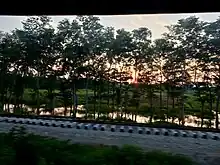Gorakhpur Zoo
Shaheed Ashfaq Ullah Khan Zoological Park or Gorakhpur Zoological Garden commonly known as Gorakhpur Zoo is in Gorakhpur, Uttar Pradesh, India.[2] It is named after independence activist Ashfaqulla Khan. With an area of 121 acres,[1] it is the second biggest zoo in the state after Kanpur Zoological Park. It was opened for public on 27 March 2021.
| Gorakhpur Zoo | |
|---|---|
| 26.7192°N 83.4084°E | |
| Date opened | 27 March 2021 |
| Location | Taramandal, Near Naya Savera Nauka Vihar, Gorakhpur, Uttar Pradesh, India |
| Land area | 121 acres[1] |
| Website | gorakhpurzoo |
Location
Shaheed Ashfaq Ullah Khan Zoological Park is located on the Gorakhpur-Deoria bypass road. It is about 8 km away from Gorakhpur railway/bus station and about 11 km from the airport. This zoological park is the first in Purvanchal and the third of Uttar Pradesh. The historical Ramgarh Tal Lake is situated on one side of it. Gorakhnath temple is 10 km from the zoo.
The city of Gorakhpur is surrounded by the Rapti and Rohin rivers. Kapilvastu, the birth place of Gautam Buddha and Kushinagar, the place of Parinirvana, is also close to this city. It is located in proximity to the circuit house, Buddhist museum, constellation, boating and water sports complex.
About

The zoo is established in a total area of 121.34 acres (49.10 ha). About 34 acres are in the form of wetland and 30 acres is dense forest. Tree plantation has been done in an additional area of 20 acres, that is, about 46.5 percent of the area of the zoological park is covered with trees. Due to the development of the zoological park as a green belt / forest like area, the entire area of the zoological park acts as a carbon sink and "green lungs" for the area.
Arrangements have been made to keep 387 wild animals of more than 58 species, including Asiatic Lion, tiger, leopard, rhinoceros, zebra, hippopotamus, 2 species of bear, 3 species of monkey, 6 species of deer. Various species of reptiles and birds including hyena, wolf, aquarium, butterfly park and crocodile, are the center of attraction. It has quarantine centers, rescue centers, a post-mortem house, a kitchen and feed store. Since Gorakhpur Zoological Park is the only one in Purvanchal, establishment of rescue centers facilitate to rescue wild animals straying from the forests of Purvanchal and its adjoining Bihar state and Nepal in the populated area and for their immediate rescue and treatment and thus avoiding man-animal conflict.
A veterinary hospital has been built for monitoring the health of wild animals, scientific study of their nature and research. Apart from this, incinerators have also been installed for disposal of dead wild animals and veterinary waste. Along with this, the zoo has public facilities like an interpretation center, 7D theatre, open air theater, ATM booth, souvenir shops, cafeteria, kiosk, gazebo, resting shed, benches, battery operated vehicle, toilet block. Arrangements have also been made of wheel chair for handicapped, pram for babies, R.O. water points and ODOP (One District One Product) shops. Safety and security includes CCTV, fire extinguishers and alarm system, solar fencing for carnivores, round the clock security arrangements and emergency exits.
There are currently more than 226 animals available in the zoo, including lions, tigers, rhinos, hyenas, hippos, bears, monkeys, different types of deer, 10 types of birds and a beautiful aquarium. In March 2021, the Uttar Pradesh Chief Minister Yogi Adityanath inaugurated the zoo.
References
- "गोरखपुर में 181.82 करोड़ रुपये की लागत से 121.34 एकड़ में बनेगा प्राणि उद्यान" [Zoological park to be built on 121.34 acres in Gorakhpur at a cost of Rs 181.82 crore]. udaipurkiran.in (in Hindi). 18 June 2019. Archived from the original on 19 June 2019.
- "Gorakhpur Zoological Garden". upforest.gov.in. Environment, Forest and Climate Change Department, Government of Uttar Pradesh, India. Archived from the original on 12 November 2019. Retrieved 14 January 2019.
Further reading
- Chand, Pragati (24 June 2022). "गोरखपुर चिड़ियाघर में 180 वन्यजीवों को मिली नई जिंदगी, यहां घायल जानवरों का इलाज कर बचाया जा रहा उनका जीवन" [180 wildlife got new life in Gorakhpur zoo, their lives are being saved by treating injured animals here]. Dainik Jagran (in Hindi).
- IANS (28 February 2021). "Etawah's lions shifted to Gorakhpur zoo". The Statesman.
- "Kanpur zoo tiger finds a new home in Gorakhpur". Ahmedabad Mirror. 2 August 2021.
- IANS (6 June 2021). "Gorakhpur zoo gets 5 duck hatchlings". Mangalorean.com.
- पाण्डेय, राजीव दत्त (12 August 2018). "गोरखपुर दौरे के पूर्व मुख्यमंत्री ने चिड़ियाघर के लिए दिया तोहफा" [Before the Gorakhpur tour, the Chief Minister gave a gift to the zoo]. Livehindustan.com.
- "Yogi Adityanath Welcomes 2 Assam Rhinos At Gorakhpur Zoo". Pratidin Time. 18 March 2022.
- "गोरखपुर: 10 माह में बचाए गए 80 वन्य जीवों का घर बना चिड़ियाघर" [Gorakhpur: Zoo became home to 80 wild animals saved in 10 months]. Amar Ujala (in Hindi). 17 February 2022.
- Primary sources
- Letters, Central Zoo Authority (PDF), Central Zoo Authority, Ministry of Environment, Forest and Climate Change
- Risk Assessment and Emergency Preparedness Plan. Conceptual Plan. Environment Consultant. (PDF), environmentclearance.nic.in, archived from the original (PDF) on 11 February 2022
{{citation}}: CS1 maint: others (link)